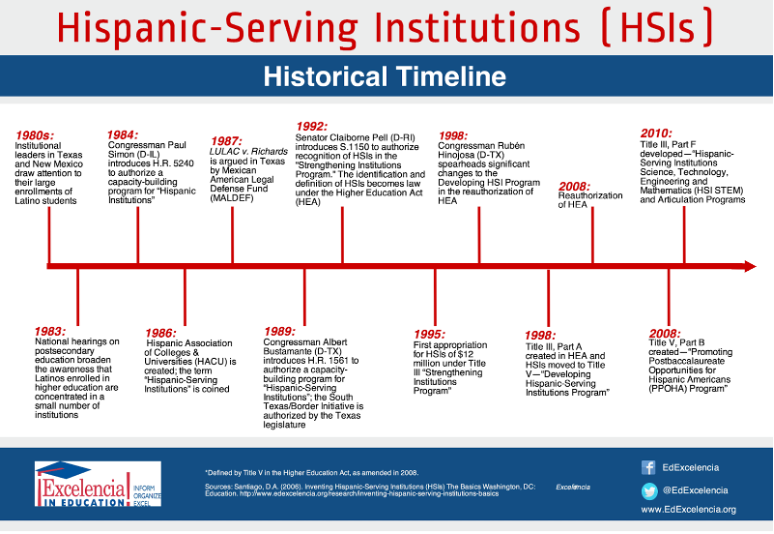Thomas O'Donnell, Ph.D., Principal Analyst, Office of Academic Diversity
twodonnell@ucdavis.edu
In 1962, the first Chicano student enrolled at UC Davis and graduated with the class of 1966. Since then, enrollment has grown tremendously with over 4,000 Chicanx/Latinx students enrolled in 2010 and over 8,000 in the fall of 2021. Including AB540 and Undocumented rising scholars, more than 25% of our undergraduate population identifies as Chicanx/Latinx. Although not yet an HSI according to the Department of Education, UC Davis serves more Hispanic students than 89% of currently designated HSIs and 99% of emerging HSIs. The campus is federally-designated an Asian American, Native American, Pacific Islander Serving Institution (AANAPISI) and a Minority Serving Institution (MSI).
The US Department of Education, Hispanic-Serving Institutions (HSI) Division provides grant funding to institutions of higher education to assist with strengthening institutional programs, facilities, and services to expand the educational opportunities for Hispanic Americans and other underrepresented populations.
An HSI is defined as an eligible institution that “has an enrollment of undergraduate full-time equivalent students that is at least 25 percent Hispanic students at the end of the award year immediately preceding the date of application.” Excelencia in Education, an organization “dedicated to Latino student success in higher education” created the infographic below charting the history of the HSI designation.

The federal designation of an HSI is a recognition of the large concentration of Chicanx/Latinx (“Chi/Lat”) students some colleges enroll and the socio-economic reality that Chi/Lat students face higher hurdles even getting into college and then in completing a degree program, compared to their white peers. The Hispanic Association of Colleges and Universities (HACU), another leading U.S. organization advocating for Hispanic education advancement maintains an interesting and insightful record of statistics and facts about Hispanics in higher education.
A Note on Terminology
“Hispanic” is the term utilized by the U.S. Department of Education and organizations such as HACU–the Hispanic Association of Colleges and Universities. Antonio Campos, writing for UCOP, explains that it “refers to any of the peoples in the Americas and Spain who speak Spanish or are descended from Spanish-speaking communities. It was coined in the 1970s by the U.S. Census Bureau to offer a pan-ethnic name for peoples such as Puerto Ricans, Mexican Americans, Cuban Americans and others, whose social, economic and political needs were often ignored.” In the articles that follow in this series, the term will generally be used in the context of discussing the federal government’s designation. “Chicana/Chicano” refers to a person who is native of, or descends from, Mexico and who lives in the United States. The term became widely used during the Chicano Movement of the 1960s by many Mexican Americans to express a political stance founded on pride in a shared cultural, ethnic, and community identity. “Latina/Latino” refers to someone who is native of, or descends from, a Latin American country. Finally, according to our own El Centro: The purpose of using "x" in "Chicanx/Latinx" is to allow for the Chicana, Chicano, Latina, Latino community to be gender expansive, meaning it includes all those who identify and don't identify within the gender spectrum. Some authors will use the term “Chi/Lat” as above to be as inclusive as possible. To read more about terminology please read: Antonio Campos, “What’s the difference between Hispanic, Latino and Latinx? On navigating identity, language and community from a scholarly and first-person perspective”
There are 559 HSIs in the United States, 142 (30%) of them are in California. Across the U.S. only 17 are R1 HSIs, 4 of them in California, all within the University of California system: Riverside (2008), Santa Barbara (2015), Santa Cruz (2015), and Irvine (2017). UC Merced has been a HSI since 2010. Davis, Los Angeles, San Diego, and Berkeley are all “emerging HSIs,” meaning they are very close to achieving the 25% threshold.
Although the specific goal of becoming a HSI was articulated at UC Davis in 2008, the journey of reaching today stretches back much further, like back to the late 1960s further. And that history is what this new series is about. As we look forward to the opportunities and expectations of UC Davis as a HSI, we must also be fully aware of the countless people, victories, setbacks, and sacrifices that have been made in the decades leading up to this moment. Thus, this new series of short articles will explore that history. In our next several posts we will explain more about the project.
As we begin the task of re-discovering and writing that history, we want to share some of the highlights (and some lowlights) we find along the way. So please follow along. We will post every-other week on Thursdays.
Read the next article in this series:
Writing Our HSItory, The Project
Read More:
Mendez, Jesse Perez, Fred A. Bonner II, Josephine Méndez-Negrete, and Robert T. Palmer, eds. Hispanic-Serving Institutions in American Higher Education: Their Origin, and Present and Future Challenges. Sterling, Virginia: Stylus Publishing. 2015.
Samayoa, Andrés Castro and Marybeth Gasman, eds. A Primer on Minority Serving Institutions. New York: Routledge. 2019.
UC Davis HSI Taskforce. “Investing in Rising Scholars and Serving the State of California: What It Means for UC Davis to be a Hispanic Serving Institution.” 2019.

